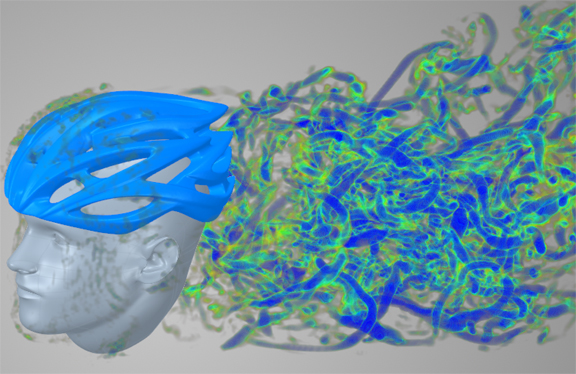
Fluid results like vorticity are instant, and provide insight on recirculation zones as well as velocity (image courtesy of ANSYS).
February 13, 2018
With today’s launch of ANSYS Discovery Live, one of the biggest names in simulation takes a big step in the push to democratize simulation.
Late last year, ANSYS unveiled ANSYS Discovery Live, billed as “real-time simulation for rapid product exploration.” Following the announcement, the company made the early version available for test drive. (For DE‘s previous coverage of the announcement, read Beth Stackpole’s post here.) This week marks the product’s commercial launch.
Though ANSYS products are usually associated with expert users, ANSYS Discovery Live takes a dramatic departure, by simplifying simulation and analysis to a series of simple steps. The approach marks ANSYS Discovery Live as a product aimed at designers—a much wider user pool than traditional simulation users.
The speed and ease of use in Discovery Live comes from two features: (1) SpaceClaim’s direct-editing technology; (2) NVIDIA GPU-driven parallel processing.
 In ANSYS Discovery Live, the same model can be used to perform thermal and fluid simulations, and results can easily be toggled between the two (image courtesy of ANSYS).
In ANSYS Discovery Live, the same model can be used to perform thermal and fluid simulations, and results can easily be toggled between the two (image courtesy of ANSYS). In ANSYS Discovery Live, fluid results like velocity are instant, and provide insight on recirculation zones as well as velocity (image courtesy of ANSYS).
In ANSYS Discovery Live, fluid results like velocity are instant, and provide insight on recirculation zones as well as velocity (image courtesy of ANSYS).Direct Editing in the Simulation Environment
In 2014, ANSYS acquired the direct-editing software maker SpaceClaim. Different from parametric modelers, direct modelers allow users to push, pull, and move geometric features without meticulously deconstructing the models. For making quick geometric changes, direct modeling is considered more efficient.
Simulation programs are not meant to be geometry modeling programs. Therefore, the geometry manipulation tools included in them tend to be highly limited, mainly intended to simplify geometry or remove excessive details.
The integration of SpaceClaim’s technology in ANSYS Discovery Live results in a simulation environment where users can move and adjust geometric features with much greater freedom. For many cases of design exploration, the direct editing tools in ANSYS Discovery Live let users bypass the need to go back to the CAD program to make the change and regenerate the simulation geometry, thus speeding up the iterative analysis.
GPU-Powered Analysis
ANSYS Discovery Live takes advantage of the massively parallel architecture of GPUs—specifically, NVIDIA GPUs. The real-time aspect of the software—the ability to visualize the physics, structural deformation, and animated fluid or air flows—comes from the software’s architecture that harvests the GPU’s processing power.
The company is currently looking into using ANSYS Discovery Live on virtual machines (VMs) with designated virtual GPUs.
 GPU-powered parallel processing allows instant display of complex fluid flow and thermal results (image courtesy of ANSYS).
GPU-powered parallel processing allows instant display of complex fluid flow and thermal results (image courtesy of ANSYS).Simplicity is the Goal
ANSYS Discovery Live offers structural analysis, internal fluid analysis, lightweighting, thermal analysis, external fluid analysis, and model analysis. The software automatically decides the appropriate meshing strategy and processes the model, removing one of the steps that tend to stump designers with limited experience in simulation.
The move to expand the use of simulation is happening in several ways: (1) CAD-integrated simulation; (2) app-style simulation; (3) simplified analysis programs aimed at designers. ANSYS Discovery Live falls into the last type.
Many expert analysis software makers attempting to attract designers meet with limited success because they present a slimmer, lighter version of their core products rather than perform a UI overhaul. With a straightforward UI and the step-by-step analysis setup, ANSYS Discovery Live is expected to attract even those with limited CAD experience. It may also be a companion to the company’s existing higher end products, such as ANSYS AIM.
ANSYS Discovery Live is a self-contained rapid analysis environment. It’s complemented by other products in the ANSYS Discovery Family: Discovery SpaceClaim and Discovery AIM.
Subscribe to our FREE magazine, FREE email newsletters or both!
About the Author
Kenneth Wong is Digital Engineering’s resident blogger and senior editor. Email him at [email protected] or share your thoughts on this article at digitaleng.news/facebook.
Follow DE





